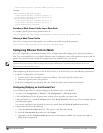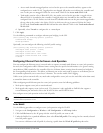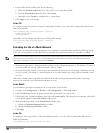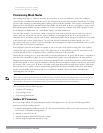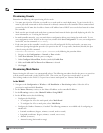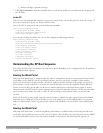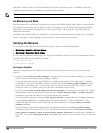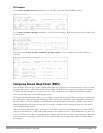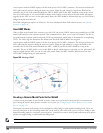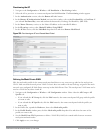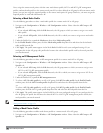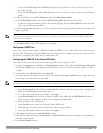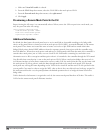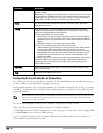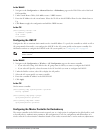
472 | SecureEnterpriseMesh DellPowerConnectW-SeriesArubaOS6.2 | User Guide
A mesh point sends the DHCP request with the mesh private VLAN (MPV) parameter. The mesh point learns the
MPV value from the response during the mesh association. When the split tunnel is setup for the RMP on the
controller, the VLAN of the tunnel should be the MPV.A DHCP pool for the MPV should be setup on the switch.
The use of MPV makes it easy for the RMP to decide which requests to forward over the split tunnel. All requests
tagged with the MPV are sent over the split tunnel. Hence the MPV should be different from any user VLAN that is
bridged using the mesh network.
The RMP configuration requires an AP license. For more information about Dell software licenses, see Software
Licenses on page 100.”
How RMP Works
When a client at the branch office associates to a split VAP, the client’s DHCP requests are forwarded over a GRE
tunnel (split tunnel) to the corporate network. This communication is done over a secure VPN tunnel. The IPs are
assigned from the corporate pool based on the VLAN tag information, which helps to determine the corresponding
VLAN. The VLAN tag also determines the subnet from which the DHCP address has assigned.
A mesh point sends the DHCP request with the mesh private VLAN (MPV) parameter. The mesh point learns the
MPV value from the response during the mesh association. When the split tunnel is set up for the RMP on the
controller, the VLAN of the tunnel should be the MPV. A DHCP pool for the MPV should be set up on the
controller. The use of MPV makes it easy for the RMP to decide which requests to forward over the split tunnel. All
requests tagged with the MPV are sent over the split tunnel. Hence the MPV should be different from any user
VLAN that is bridged using the mesh network.
Figure 138: Working of RMP
Creating a Remote Mesh Portal In the WebUI
A remote mesh portal must be provisioned as both a remote access point and a mesh portal. For instructions on
provisioning the remote mesh portal as a remote access point, see "Configuring the Secure Remote Access Point
Service" on page 512.
Wired ports on remote mesh portals can be configured in either bridge or split-tunnel forwarding mode. There are,
however, limitations to the forwarding modes that can be used by other mesh node types. Do not use bridge or split-
tunnel forwarding mode for wired ports on mesh points. Virtual APs on remote mesh portals and remote mesh points
also do not support bridge or split-tunnel forwarding mode.
NOTE: A remote mesh portal does not support bridge mode Virtual APs or offline Virtual APs.



